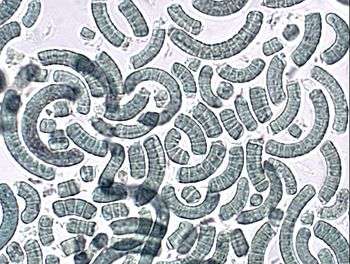Arthrospira
| Arthrospira | |
|---|---|
| Scientific classification | |
| Kingdom: | Bacteria |
| Phylum: | Cyanobacteria |
| Class: | Cyanophyceae |
| Order: | Oscillatoriales |
| Family: | Phormidiaceae |
| Genus: | Arthrospira |
| Species | |
|
About 35. | |

Arthrospira is a genus of free-floating filamentous cyanobacteria characterized by cylindrical, multicellular trichomes in an open left-hand helix. A dietary supplement is made from A. platensis and A. maxima, known as spirulina.[1] The A. maxima and A. platensis species were once classified in the genus Spirulina. ″Although the introduction of two separate genera [Arthrospira and Spirulina] is now generally accepted, there has been much dispute in the past and the resulting taxonomical confusion is tremendous″.[2] ″
The common name, spirulina, refers to the dried biomass of A. platensis,[3] which belongs to the oxygenic photosynthetic bacteria that cover the groups Cyanobacteria and Prochlorales. These photosynthetic organisms, Cyanobacteria, were first considered as algae until 1962 and for the first time, these blue-green algae were added to prokaryote kingdom and proposed to call these microorganisms as Cyanobacteria [4] where algae are considered to be a very large and diverse group of eukaryotic organisms. This designation was accepted and published in 1974 by Bergey's Manual of Determinative Bacteriology.[5] Scientifically, quite a distinction exists between Spirulina and Arthrospira genera. Stizenberger, in 1852, gave the name Arthrospira based on the septa presence, helical form, and multicellular structure, and Gomont, in 1892, confirmed the aseptate form of the Spirulina genus. Geitler in 1932 reunified both members designating them as Spirulina without considering the septum.[6] The worldwide research on microalgae was carried out in the name of Spirulina, but the original species exploited as food with excellent health properties belongs to genus Arthrospira. This common difference between scientists and customers is difficult to change.[5] The Arthrospira genus comprises helical trichomes of varying size and with various degrees of coiling, including tightly coiled morphology to even a straight form. The filaments are solitary and reproduce by binary fission, and the cells of the trichomes vary from 2 to 12 μm and can sometime reach 16 μm. Species of the genus Arthrospira have been isolated from alkaline brackish and saline waters in tropical and subtropical regions. Among the various species included in the genus, A. platensis is the most widely distributed and is mainly found in Africa, but also in Asia. A. maxima is believed to be found in California and Mexico.[6] They are now agreed to be in fact Arthrospira; nevertheless, and somewhat confusingly, the older term Spirulina remains in use for historical reasons.[1][7] However, current taxonomy claims that the name spirulina for strains used as food supplements is inappropriate, and agreement exists that Arthrospira is a distinct genus, consisting of over 30 different species, including A. platensis and A. maxima.[8]
A. platensis and A. maxima occur naturally in tropical and subtropical lakes with high pH and high concentrations of carbonate and bicarbonate.[9] A. platensis occurs in Africa, Asia, and South America, whereas A. maxima is confined to Central America, and A. pacifica is endemic to the Hawaiian islands.[7] Most cultivated spirulina is produced in open-channel raceway ponds, with paddle-wheels used to agitate the water.[9] The largest commercial producers of spirulina are located in the United States, Thailand, India, Taiwan, China, Pakistan, Burma (a.k.a. Myanmar), Greece and Chile.[7]
References
- 1 2 Ciferri, O. (1983). "Spirulina, the edible microorganism". Microbiological reviews. 47 (4): 551–578. PMC 283708
 . PMID 6420655.
. PMID 6420655. - ↑ Mühling, Martin (March 2000). Characterization of Arthrospira (Spirulina) Strains (Ph.D.). University of Durham. Archived (PDF) from the original on 2016-01-23. Retrieved 2016-01-23.
- ↑ Gershwin, ME; Belay, A (2007). Spirulina in human nutrition and health. CRC Press, USA.
- ↑ Stanier, RY; Van Niel, Y (January 1962). "The concept of a bacterium". Arch Mikrobiol. 42: 17–35.
- 1 2 Sánchez, Bernal-Castillo; Van Niel, J; Rozo, C; Rodríguez, I (2003). "Spirulina (arthrospira): an edible microorganism: a review". Universitas Scientiarum. 8 (1): 7–24.
- 1 2 Siva Kiran, RR; Madhu GM; Satyanarayana SV (2016). "Spirulina in combating Protein Energy Malnutrition (PEM) and Protein Energy Wasting (PEW) - A review". Journal of Nutrition Research. Retrieved February 20, 2016.
- 1 2 3 Vonshak, A. (ed.). Spirulina platensis (Arthrospira): Physiology, Cell-biology and Biotechnology. London: Taylor & Francis, 1997.
- ↑ Takatomo Fujisawa; Rei Narikawa; Shinobu Okamoto; Shigeki Ehira; Hidehisa Yoshimura; Iwane Suzuki; Tatsuru Masuda; Mari Mochimaru; Shinichi Takaichi; Koichiro Awai; Mitsuo Sekine; Hiroshi Horikawa; Isao Yashiro; Seiha Omata; Hiromi Takarada; Yoko Katano; Hiroki Kosugi; Satoshi Tanikawa; Kazuko Ohmori; Naoki Sato; Masahiko Ikeuchi; Nobuyuki Fujita & Masayuki Ohmori (2010-03-04). "Genomic Structure of an Economically Important Cyanobacterium, Arthrospira (Spirulina) platensis NIES-39". Oxford University Press. PMC 2853384
 . In its turn, it references:
Castenholz R.W.; Rippka R.; Herdman M.; Wilmotte A. (2007). Boone D.R.; Castenholz R.W.; Garrity G.M., eds. Bergey's Manual of Systematic Bacteriology (2nd ed.). Springer: Berlin. pp. 542–3.
. In its turn, it references:
Castenholz R.W.; Rippka R.; Herdman M.; Wilmotte A. (2007). Boone D.R.; Castenholz R.W.; Garrity G.M., eds. Bergey's Manual of Systematic Bacteriology (2nd ed.). Springer: Berlin. pp. 542–3. - 1 2 Habib, M. Ahsan B.; Parvin, Mashuda; Huntington, Tim C.; Hasan, Mohammad R. (2008). "A Review on Culture, Production and Use of Spirulina as Food dor Humans and Feeds for Domestic Animals and Fish" (PDF). Food and Agriculture Organization of The United Nations. Retrieved November 20, 2011.
External links
- Guiry, M.D.; Guiry, G.M. (2008). "Arthrospira". AlgaeBase. World-wide electronic publication, National University of Ireland, Galway.